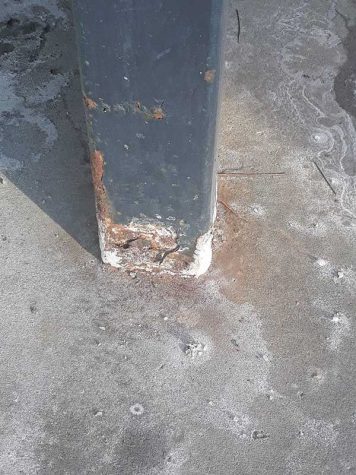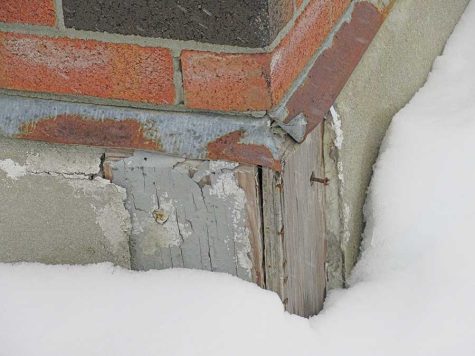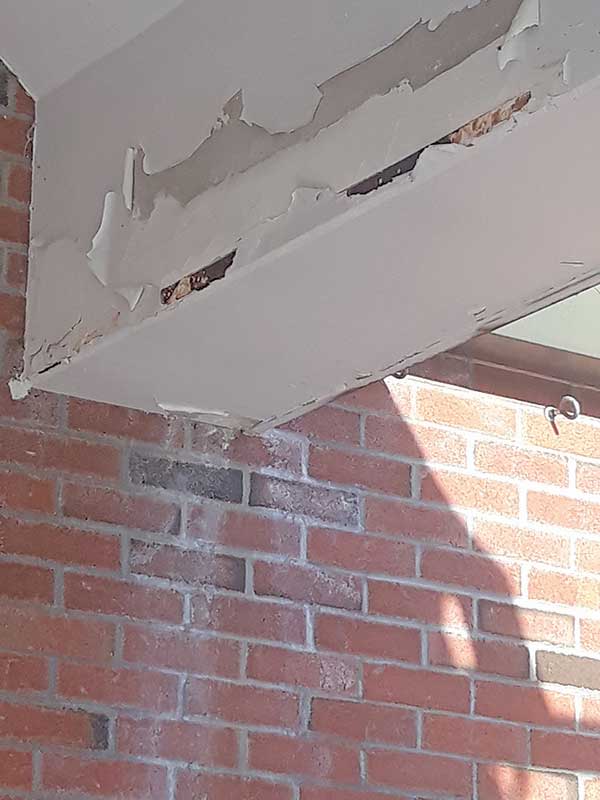Edifice wrecks: kicking the maintenance can down the road
Problems under the SHAPE portico
Deferred maintenance is a real issue in the Vermont State College system and NVU-Johnson is no exception. Peeling paint and cracked concrete can be spotted throughout the buildings here, both inside and out.
Technically, deferred maintenance is essentially an accounting term that indicates a postponement of any sort of maintenance to a piece of real estate.
Instead of fixing the issue in the present and incurring the very real cost of a project, the maintenance is put off or delayed and recorded as deferred maintenance in the books of the firm who holds the property.
NVU Interim President John Mills had experience handling deferred maintenance situations during his previous posts at private universities and colleges, but this is his first time tackling the issue at a public one.
“Deferred maintenance is not unique in the Vermont State College system,” said Mills. “In higher education, deferred maintenance is one of the biggest elephants in the closet.”
This is a problem that has been creeping up on the Johnson campus for some time now. “A lot of work went on when the enrollment was growing in the 70s, the 80s, and into the 2000s,” Mills said. “It was an investment in buildings. And of course, the idea was, ‘we’ll pay and keep these buildings up because we’re just going to keep growing.’ Of course, that changed dramatically after the 2008 financial downturn.”
Mills said that compounding the problem is the demographic situation of a decreasing but long- predicted decline in the number of graduating high school students in the Northeast. “So, that paired with the economic downturn created a lack of investment in state institutions,” he added.
Lack of funding and stagnant enrollment rates are certainly feeding into the issue of deferred maintenance on the Johnson campus. The longer necessary upgrades and repairs are postponed, the more expensive they become.

The problem with deferred maintenance is that buildings as they age out actually become more expensive to run,” said Mills. “Then they become more expensive to fix. So, the deferred maintenance grows. It keeps growing with time because of the aging out and the problems of replacements. For example, after a certain amount of time, and I’m not referring to any specific building here at Johnson, there are systems within the building that if you want to upgrade them, you can’t because they’re no longer upgradeable. You would now have to replace them for more money. So, it’s a national problem in higher education, and it’s very significant within the Vermont State College System.”
With the Vermont State University transformation, big money issues like deferred maintenance will become more important than ever as VSCS board members consider whether to invest in a facility or to let it go. “It is a very difficult question,” Mills said. “It is part of the transformation process to determine what you need to do to upgrade your facilities, so you don’t end up with failures within the system … The reduced enrollment is really going to make us look at what buildings do we need, what buildings do we have to upgrade, what buildings can we not upgrade, or maybe not even have anymore. These are all questions that have to be discussed across the whole [campus] system:Johnson, Lyndon, Castleton and Vermont Tech.”
Certain maintenance issues on the Johnson campus are clear to the naked eye. From rusted support pillars at Martinetti Hall, to crumbling exterior walls at SHAPE, to broken floor tiles in the college apartments. While it may seem like an easy thing to fix, Mills notes that maintenance comes with a very real cost.
“Deferred maintenance is the dollar amount that you carry on your books, but to fix it, there is real cash that needs to be spent…and that cash has to come from somewhere,’’ said Mills. “That is the challenge. How much will be available from the Legislature, from the board, and from enrollment returns? Who allows this deferred maintenance question to be attacked?”
On the positive side, these issues are not unknown to the Vermont State College system and steps are already being taken to assess what will need to be done on the Johnson campus as the transformation to Vermont State University proceeds.
Manager of Transformation Projects and Planning Mike Stevens says that deferred maintenance is not a terrible thing. “Deferred maintenance isn’t a scary term. Deferred maintenance exists everywhere in every building,” he said. “As soon as you build a new home, you’re starting to accumulate deferred maintenance on whatever you should be planning. You should be planning for the cost on day one.”
Knowing this, the question becomes both how much deferred maintenance exists on Vermont State College campuses, and how much money will we have to address those issues?
There is a large gap between what the campuses need collectively and what they are receiving from the state according to Vermont State Colleges Chief Financial and Operating Officer Sharron Scott. “At present, the Vermont State Colleges receive approximately $2 million annually to support deferred maintenance at all four of our colleges, including Community College of Vermont. For Castleton, NVU, and VTC, that amount is approximately $7 million short of what we need to maintain our building envelope and mechanical systems without increasing our deferred maintenance.”
What, exactly, is the value of the current deferred maintenance projects on each campus?
“We have some ideas already,” said Mills. “The program has started and there has been a very robust reveal of the Vermont State College system by a company that the chancellor’s office brought in called Guardian. I do know the reports are basically done. The energy side of it has not been done, but the actual physical side has been done.”

However it is figured, maintenance deferred is inevitably more costly than an immediate fix. “Deferred maintenance can lead to not just adding up a number; it can lead to a linear growth in the cost of maintaining a building,” Mills said. “For example, we need $10,000 to fix a hypothetical building this year, then boom, next year that replacement might now require $12,000. So, it’s really deciding where you’re going to put your maintenance dollars to prevent that growth…And it’s not just buildings, it’s grounds and everything else. I always use buildings as an example because buildings are the most expensive.”
Both Mills and Stevens stressed that deferred maintenance shouldn’t be viewed as a completely negative thing. “I actually think, through the unification, all of our campuses are going to see benefits from the unification on deferred maintenance,” Stevens said. “Past trends would predict the future of our campuses being very challenged to deal with our deferred maintenance at any one of the institutions, but as we move to a unified organization, and we continue to shape this new vision, we will likely see a change in the support that we receive from the state.”
As Vermont State University closes in on becoming a tangible reality, deferred maintenance will be just one of the many challenges facing the Vermont State Colleges system. The Legislature’s willingness to provide crucial funds to sustain the campuses will be a major one.




